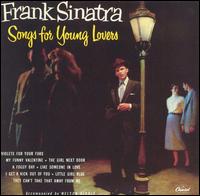
Close to You is the eleventh studio album by American musician Frank Sinatra, accompanied by the Hollywood String Quartet.
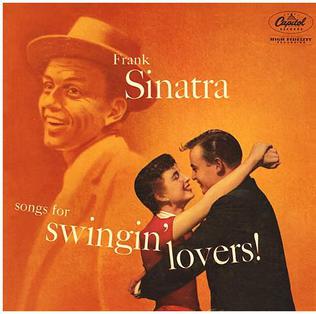
Songs for Swingin' Lovers! is the tenth studio album by American singer Frank Sinatra, and his fourth for Capitol Records. It was arranged by Nelson Riddle and released in March 1956 on LP and January 1987 on CD. It was the first album ever to top the UK Albums Chart.

No One Cares is the seventeenth studio album by Frank Sinatra, released on July 20, 1959. It is generally considered a sequel to Sinatra's 1957 album Where Are You?, and shares a similar sad and lonesome, gloomy theme and concept as In the Wee Small Hours and Only the Lonely.

A Swingin' Affair! is the twelfth studio album by Frank Sinatra. It is sometimes mentioned as the sequel to Songs for Swingin' Lovers.
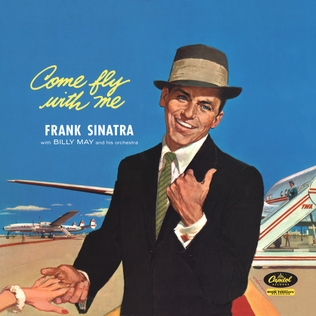
Come Fly with Me is the fourteenth studio album by American singer Frank Sinatra, released in 1958.

My Kind of Broadway is a 1965 studio album by Frank Sinatra. It is a collection of songs from various musicals, pieced together from various recording sessions over the previous four years. The album features songs from nine arrangers and composers, the most ever on a single Sinatra album. While the title of the album is "My Kind of Broadway", both the Gershwin songs on the album "They Can't Take That Away From Me" and "Nice Work If You Can Get It" were written by George and Ira Gershwin for films and not for Broadway musicals.

She Shot Me Down is a 1981 album by American singer Frank Sinatra.

The Complete Ella Fitzgerald Song Books were a series of eight studio albums released in irregular intervals between 1956 and 1964, recorded by the American jazz singer Ella Fitzgerald, supported by a variety of orchestras, big bands, and small jazz combos.

The Man I Love is an album by jazz singer Peggy Lee with an orchestra arranged by Nelson Riddle and conducted by Frank Sinatra. This was Lee's first album after returning to Capitol.
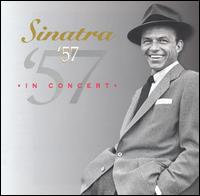
Sinatra '57 in Concert is a 1999 live album by the American singer Frank Sinatra. It is a complete recording of a concert performed at the Seattle Civic Auditorium on June 9, 1957. Arranger Nelson Riddle conducted the 26-piece orchestra at the event.

Concepts is a 1992 sixteen-disc box set compilation of the U.S. singer Frank Sinatra.

When Harry Met Sally... is the soundtrack to the movie When Harry Met Sally... starring Billy Crystal and Meg Ryan. The songs are performed by pianist Harry Connick Jr., who won the Grammy Award for Best Jazz Male Vocal Performance.

Love is a studio album by Rosemary Clooney, arranged by Nelson Riddle, recorded in 1961 but not released until 1963.

Romance: Songs from the Heart is an album recorded in November 5, 1953 – March 22, 1961 by Frank Sinatra, released posthumously in 2007, that consists of 21 tracks he recorded for Capitol Records. An alternate version of "Nice 'n' Easy" is included on the disc. The songs were remastered for digital from their original analogue versions.
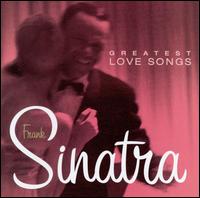
Greatest Love Songs is a 2002 compilation album by American singer Frank Sinatra, containing 22 love songs.

Duets/Duets II: 90th Birthday Limited Celebration Edition is a two-disc compilation album set by Frank Sinatra. This was released to celebrate his 90th birthday. The album includes a duet with Willie Nelson on "My Way".

Classic Sinatra: His Great Performances 1953–1960 is a 2000 compilation album by Frank Sinatra, containing twenty tracks he recorded for Capitol Records.

Sinatra 80th: All the Best is a double compilation disc album by Frank Sinatra. On the final track, "The Christmas Song" is recorded both by Sinatra and Nat King Cole. The title, like the previous album, was released and named to coincide with Frank Sinatra's birthday, as he was celebrating his 80th at the time.

Sinatra: Best of the Best is a 2011 double compilation album by American singer Frank Sinatra.
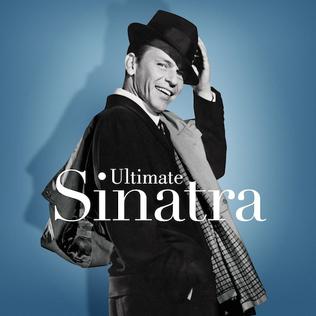
Ultimate Sinatra is a 2015 compilation album by American singer Frank Sinatra released specifically to commemorate the 100-year anniversary of his birth. The collection consists of songs recorded from 1939 to 1979 during his sessions for Columbia Records, Capitol Records, and Reprise Records. The 4-CD set consists of 100 songs, plus a never before released bonus track of a rehearsal recording of "The Surrey With the Fringe On Top" from the musical Oklahoma! This edition also features an 80-page booklet with a new essay by Sinatra historian and author Charles Pignone, as well as rare photos and quotes from Sinatra, his family members and key collaborators.
